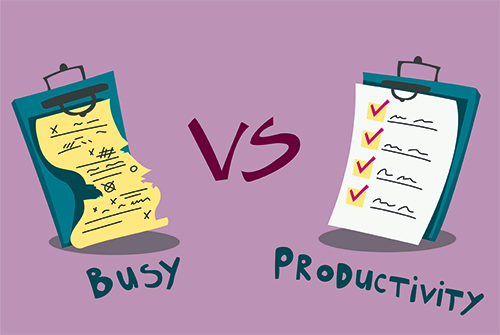
In business and in life, people often utter phrases such as, “I’m too busy,” or “I don’t have the bandwidth.” Does anyone ever stop to question the accuracy and meaning of these claims? If they did, they might realize that time and effort do not always correlate to effectiveness. That’s why it’s important for workers and managers to assess what type of work results in productivity, value, and positive contributions to established goals.
Busy versus productive workers
Being busy doesn’t always mean being productive or producing quality work. The reality is that busy workers lack structure or strategy. They never have enough time to do all the things they want to accomplish in a day. They lack set timelines, and they believe that not only does everything need to be tackled immediately, but also simultaneously. Their expectations for themselves and their peers as well as their lack of delegation and collaboration skills lead to workers splitting their focus and being stuck on earlier unsuccessful attempts at previous tasks.
As a result, busy workers can be a drain on companies. They mistakenly believe that being busy leads to quality deliverables, but that’s not the case. Constantly busy workers deliver low-quality work under the guise of major achievements. The trickle-down effects of this are noticeable, leading to dissatisfied and burnt-out workers because they have no time to learn new technologies, methodologies, or upgrade their skills.
When people are working 12-14 hours a day, busyness also bleeds into their home lives. No successful modern organization should aspire to have a continuously switched-on workforce. Unless a company can identify why so many employees are always busy yet cannot achieve expected deliverables, the workforce will always fall behind.
On the other hand, productive workers not only have a clear sense of the goals they need to achieve, but they also know how to do so within a specific time frame. They understand what high-risk, high-value tasks they need to prioritize over new, mundane tasks that should take a lower priority. Unlike busy workers, productive workers know the importance of working on one thing at a time and they set clear boundaries. They also know the tasks they can work on alone or with others, and which to delegate. And it doesn’t stop there. Even when delegating, productive workers are transparent with their expectations of others as well as themselves. They know when their mental capabilities are drained and they need to move on to a different task or take a break before tackling the next challenge.
These are important skills because for a workplace to operate effectively, it needs employees that have clear, delineated, short-, mid-, and long-term goals (all hallmarks of productive workers). A productive workforce is not only continually looking to learn but has the time and ability to undertake ongoing education, act quickly, fail (which is inevitable), and then improve. Continuous learning represents a priority for productive workers because it is the foundation of their disciplined, focused, and highly effective approach to everything they do.
Methods for greater productivity
Productive workers still need guidance and leadership. It’s important for those in management positions to encourage a culture of continuous improvement and adoption of effective work methods, including determining how to implement new methodologies, technologies and techniques. The good news is there are several ways for management to create, facilitate and reinforce a productive workforce. Two of the most effective approaches are Agile and Scaled Agile Framework® (SAFe®).
Agile methodology recognizes that workers will never have all the information to make the best decision. There will always be challenges, which result in incomplete or limited resources, people, and information. Agile allows workers and workplaces to move quickly, to make the best decisions based on just-in-time requirements (JITRA).
When Fortune 500 companies, such as Apple, decide to launch a new product, they survey the public, create a prototype, evaluate it, and discover what works and what doesn’t. They then create a sample product, receive direct feedback from users, return to the drawing board, and take the time to make improvements before going back to their test subjects. This agile behavior is creative, has employees both taking part and learning simultaneously, and provides the space to learn, fail, and continue to make progress. CEOs and directors can encourage this behavior because it’s far better to fail early than six months down the line with nothing to show for the effort. SAFe® is a similar methodology that implements agile methodology, but whereas an agile approach focuses more on small teams with specific roles, SAFe® can go beyond that and work at an organizational level.
There are also simple tools that organizations can employ to increase productivity and cut down on busyness. Many workplaces already have Outlook or Google calendars. These can help workers to block out sections for specific tasks. For example, employees can block out 30 minutes to work on product A, take a short break, and then either return to the same task or move on to a new one, depending on the priority of the task and the progress made. The same can be done with shared team calendars. Teams can see when others have blocked out days off or what they are working on in a specific time frame that automatically tells viewers of the calendar “do not disturb.”
Making the bold moves
If organizations implement these methodologies and projects and change the mentality of working long but non-productive hours, they can effectively transition from a busy to a productive workforce. Using tools and training techniques to prioritize tasks and actively develop the culture of innovation and growth to allow employees to continuously fail and improve will result in greater collaboration and productivity rather than busyness. If CEOs and those in positions of leadership undertake these changes, they will pay off in myriad ways, including increasing their companies’ bottom lines.

